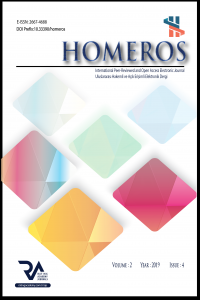Abstract
In principle, the line separating polysemy from
homonymy is clear, but in practice the criteria for identifying distinct senses
can be problematic. It is not always easy to decide at which point two meanings
of one polysemic word merit separate entries in the dictionary. The central
problem lexicologists need to tackle is precisely how to identify homonymy in
particular cases and how to distinguish meanings that are close together from
those that are far apart. Homonymy as a process represents one of the most
controversial issues in modern lexicological and semantic studies because of
the complexity of single lexical forms being associated with multiple distant
senses. Among the most productive sources of homonymy such as disintegration
(split of polysemy) and the convergent sound development we intentionally
selected a very interesting way of obtaining perfectly new lexical items
accidentally having the same outer form, as a result of a pure coincidence
between a native word and a borrowed one. Exploiting the abundant number of borrowings
from Turkish we found out that the adoption and the assimilation of these
loanwords has contributed in the process of enlarging the Albanian language
lexicon and at the same has influenced in the enrichment of the homonymous
lexical items corpus due to early contacts and as a consequence of historical,
social and cultural relations between two language communities. Analyzing
Albanian and Turkish homonymous lexical items we found out many reliable means
of backing up the claims we made and sustain our arguments that constant and
frequent interactions between the given languages have contributed in sense
relation and meaning development processes as well.
Keywords
homonymy lexical items loanwords sense relation native words convergent sound development adoption assimilation
References
- LYONS, J., (1981), Language and Linguistics, an introduction, Cambridge
- LIPKA, L., (2002), English Lexicology
- NİDA, E., (2012), Componential Analysis of Meaning. An introduction to Semantic” London
- JACKSON, H., (2008), Words, meaning, and vocabulary. An introduction to Modern English Lexicology
- LEECH, G., (1974), Semantic, Penguin books
- LYONS, J., (1979), Semantics, London
- MINKOVA, D., (2009), English words, history and structure, Cambridge
- LIPKA, L. (2002), An introduction to English lexicology, Oxford
Abstract
In principle, the line separating polysemy from
homonymy is clear, but in practice the criteria for identifying distinct senses
can be problematic. It is not always easy to decide at which point two meanings
of one polysemic word merit separate entries in the dictionary. The central
problem lexicologists need to tackle is precisely how to identify homonymy in
particular cases and how to distinguish meanings that are close together from
those that are far apart. Homonymy as a process represents one of the most
controversial issues in modern lexicological and semantic studies because of
the complexity of single lexical forms being associated with multiple distant
senses. Among the most productive sources of homonymy such as disintegration
(split of polysemy) and the convergent sound development we intentionally
selected a very interesting way of obtaining perfectly new lexical items
accidentally having the same outer form, as a result of a pure coincidence
between a native word and a borrowed one. Exploiting the abundant number of borrowings
from Turkish we found out that the adoption and the assimilation of these
loanwords has contributed in the process of enlarging the Albanian language
lexicon and at the same has influenced in the enrichment of the homonymous
lexical items corpus due to early contacts and as a consequence of historical,
social and cultural relations between two language communities. Analyzing
Albanian and Turkish homonymous lexical items we found out many reliable means
of backing up the claims we made and sustain our arguments that constant and
frequent interactions between the given languages have contributed in sense
relation and meaning development processes as well.
Keywords
homonymy lexical items loanwords sense relation native words convergent sound development adoption assimilation
References
- LYONS, J., (1981), Language and Linguistics, an introduction, Cambridge
- LIPKA, L., (2002), English Lexicology
- NİDA, E., (2012), Componential Analysis of Meaning. An introduction to Semantic” London
- JACKSON, H., (2008), Words, meaning, and vocabulary. An introduction to Modern English Lexicology
- LEECH, G., (1974), Semantic, Penguin books
- LYONS, J., (1979), Semantics, London
- MINKOVA, D., (2009), English words, history and structure, Cambridge
- LIPKA, L. (2002), An introduction to English lexicology, Oxford
Details
| Primary Language | English |
|---|---|
| Subjects | Language Studies |
| Journal Section | Research Articles |
| Authors | |
| Publication Date | October 30, 2019 |
| Published in Issue | Year 2019 Volume: 2 Issue: 4 |


